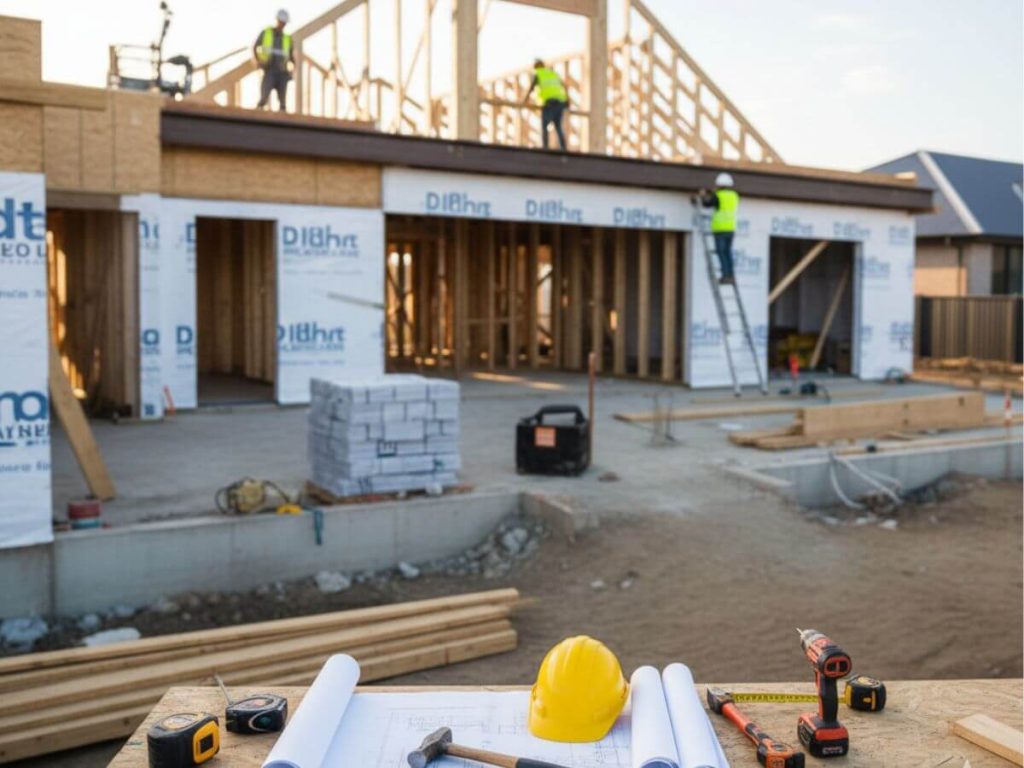Building your dream home is one of life’s biggest milestones. It’s exciting, emotional, and sometimes a little overwhelming. The first question most people ask is simple: “How long will it take?” The truth is, the Home Building Timeline & Process usually runs between six and twelve months, depending on design complexity, permits, weather, and the selections you make.
In this guide, we’ll break down the entire journey—phase by phase—so you know exactly what to expect. You’ll also get a handy checklist, an insider look at what can cause delays, and proven tips to keep things moving smoothly.
Whether you’re working with design-build companies in Los Angeles or a local builder elsewhere, this walkthrough will bring clarity to a process that often feels mysterious.
Quick Overview: Timeline for Building a House
Before diving into the details, let’s look at the big picture. This is the most common timeline for building a house that homeowners experience:
| Phase | Typical Duration |
| Pre-construction | 1–3 months |
| Foundation | 1–2 months |
| Framing | 1–2 months |
| Rough-ins (MEP systems) | 1–2 months |
| Insulation & drywall | 3–6 weeks |
| Interior finishes | 1–3 months |
| Inspections & handover | 2–4 weeks |
As you can see, each phase stacks on the next, and any delays early in the process ripple forward. That’s why understanding the Home Building Timeline & Process upfront helps you stay ahead of surprises.
What Really Impacts Your Home Building Timeline
Even with the most detailed schedule and a builder who runs a tight ship, the truth is that several variables can impact how quickly your home is completed. Some of these factors are within your control, while others depend on third parties, the weather, or simple timing. Let’s break down the biggest influences on the Home Building Timeline & Process so you know what to watch out for.
Permits & Approvals
Permits and HOA sign-offs are often the very first hurdle. Think of it like waiting at the DMV: absolutely necessary but rarely speedy. Some municipalities push paperwork through in a matter of weeks, while others require multiple rounds of review, stretching the process into months. If your lot sits in a master-planned community, HOA approvals can add another layer of red tape.
Builder Capacity & Subcontractor Scheduling
When design-build companies in Los Angeles or elsewhere juggle several projects, subcontractors such as framers, electricians, and plumbers may be booked out weeks in advance. If a subcontractor falls behind, the next phase cannot start, causing a domino effect on your timeline.
Weather & Site Conditions
Mother Nature is another wildcard. Heavy rain can turn a construction site into mud, delaying grading and foundation work. In colder climates, freezing temperatures slow down concrete curing, while in drier areas, high winds or dust storms can stall progress.
Customization Level
A production home built from a set floor plan with standard finishes typically runs on the shorter end of the schedule. On the other hand, a luxury residence designed by a design-build firm, Los Angeles that incorporates custom engineering, imported finishes, or unique architectural features can extend beyond a year.
Material Availability & Lead Times
Something as simple as a back-ordered window, specialized tile, or custom cabinetry can pause construction for weeks. Supply chain disruptions have made this an even bigger factor in recent years.
Financing & Inspection Schedules
Financing also ties into the timeline. Lenders release funds in draws tied to milestones, and each draw requires inspection or appraisal approval. If reports lag, your builder may be forced to wait for funds to continue.
Pro tip: Add a 10–15% buffer to both your time and your budget. That cushion makes delays far less stressful when they inevitably pop up.
Pre-Construction & Design (1–3 Months)
Before a shovel hits the ground, the Home Building Timeline & Process begins with pre-construction and design. This stage is all about preparation, planning, and approvals. Think of it as the foundation of your entire project—without careful attention here, delays are almost guaranteed down the road.
Financing & Pre-Approval
The first step is financial readiness. Securing a mortgage pre-approval gives you a clear budget and signals to your builder that funding is in place. Many lenders also require pre-approval before issuing construction loans.
Lot Due Diligence
Next comes evaluating the land itself. Surveys, soil tests, and zoning checks ensure your lot can handle the design you envision. Unexpected soil issues or easement restrictions can alter both cost and schedule.
Plans, Permits & Selections
Once financing and the lot are squared away, it’s time to finalize your house plans. Work closely with your builder or a Los Angeles design build firm to complete blueprints, structural engineering, and finish selections. This is when you’ll choose cabinets, flooring, and exterior details that shape the look of your home.
HOA/City Submission Timelines
With plans ready, submissions go to your HOA and local municipality. Some approvals happen within weeks, while others stretch into months, depending on jurisdiction.
Owner Action: Download a Selections Schedule Template to track decisions and deadlines. Staying organized at this stage keeps the project on track and prevents costly last-minute changes.
Construction Timeline by Phase (6–9 Months Typical)

The Home Building Timeline & Process follows what’s often called a “critical path.” This means each step must be completed before the next can begin, and delays in one stage ripple forward. Understanding how each phase works will give you a realistic picture of what’s happening on site and when you can expect major milestones.
Site Preparation & Foundation (1–2 months)
The first stage is all about preparing the ground. Crews clear the lot, level it, and address drainage. Next comes pouring footings and foundation walls. Depending on soil conditions, retaining walls or special reinforcements may be needed. Weather is a frequent obstacle here, as rain or freezing temperatures can delay concrete curing.
Framing & Exterior Shell (1–2 months)
Once the foundation is set, framing begins. This is when your home takes shape. Walls, floors, and roof trusses go up, followed by sheathing, house wrap, and roofing materials. By the end of this phase, the structure is weather-tight, allowing interior work to start.
Rough-Ins: Plumbing, Electrical, HVAC (1–2 months)
Before drywall goes up, subcontractors install plumbing pipes, electrical wiring, and HVAC ductwork. This stage is critical because once walls are closed, changes become much more costly and time-consuming.
Insulation & Drywall (3–6 weeks)
With rough-ins approved, insulation is added to meet energy codes. Then, drywall is hung, taped, and finished, transforming the skeleton of a house into real rooms.
Interior Finishes (1–3 months)
Here’s where your personality shines through. Cabinets, countertops, flooring, trim, doors, and paint bring the design to life.
Final Fixtures & Appliances (2–4 weeks)
The last step is installing light fixtures, faucets, and appliances. By this stage, your home looks nearly complete and is only weeks away from inspection and handover.
Inspections, Punch List & Handover (2–4 weeks)
Below is a realistic building a new home timeline most buyers experience during the final stretch:
- City/county inspections clear safety and code compliance.
- A punch list walk-through with your builder addresses small issues (paint touch-ups, door alignment, etc.).
- The final inspection grants your certificate of occupancy.
Production vs Semi-Custom vs Fully Custom: Timeline Comparisons
The timeline for building a new home varies greatly depending on customization. Every project falls into one of three categories—production, semi-custom, or fully custom—and the differences in design freedom directly affect how long construction takes.
Production/Tract Homes (≈4–7 months)
Production or tract homes are the quickest to complete. Builders use pre-set floor plans, standardized materials, and streamlined construction processes. Because most choices are already determined, the process avoids delays from design revisions or special orders. Many design build companies in Los Angeles rely on this model for efficiency in large developments.
Semi-Custom Homes (≈6–10 months)
Semi-custom homes strike a balance between speed and personalization. Buyers start with a base plan but can make modifications such as layout tweaks, upgraded finishes, or energy-efficient features. While this flexibility adds time compared to production builds, it still follows a structured process, keeping the overall timeline predictable.
Fully Custom Homes (≈9–18+ months)
At the other end of the spectrum are fully custom homes. Here, everything is designed from scratch, from architectural style to interior finishes. This path takes the longest, especially when working with a design-build firm, Los Angeles, specializing in luxury residences. Custom engineering, unique materials, and multiple approval stages extend the schedule significantly.
Owner Action Plan: Decisions That Keep Things on Schedule
While your builder manages the heavy lifting, your own decisions often determine whether the project moves quickly or gets stuck in delays. Staying ahead with selections and avoiding last-minute changes is one of the best ways to keep the Home Building Timeline & Process on track. Here are the key areas where your choices make the biggest difference:
- Appliances: Order appliances before framing ends so hookups are installed correctly.
- Cabinets & Flooring: Confirm selections by the drywall stage to avoid slowing down finish work.
- Lighting: Choose fixtures early; late changes often require costly rewiring.
- The Impact of Change Orders: Each change order can add 1–3 weeks. Use an Allowance Tracker Template to stay organized and avoid timeline creep.
How to Shorten the Home Building Timeline (Without Sacrificing Quality)
- Choose in-stock materials instead of custom orders.
- Make selections early and stick to them.
- Schedule weekly site meetings with your builder.
- Adopt a “no major changes after framing” policy.
These strategies are used by many design-build companies in Los Angeles to deliver homes faster without cutting corners.
Permits, Inspections & Financing Milestones
Even after the walls are up and finishes are underway, your home isn’t move-in ready until the right inspections and financial milestones are cleared. These steps are crucial for safety, code compliance, and making sure your builder gets paid on schedule. Here’s what to expect during this phase of the Home Building Timeline & Process:
City/County Inspections Required
Your project will go through several mandatory inspections. Inspectors check the foundation for structural stability, framing for accuracy, and rough-ins for plumbing, electrical, and HVAC systems. Insulation inspections confirm energy efficiency, and the final inspection ensures everything complies with local codes. A failed inspection often means small fixes, but they can still cause delays.
Draw Schedules & Appraisal Timing
Lenders release construction funds in stages rather than all at once. These draw schedules typically align with milestones like foundation, framing, drywall, and final finishes. Before funds are released, banks may require an inspection or appraisal update. Any delay here can stall construction progress.
Certificate of Occupancy Process
The last milestone is securing a certificate of occupancy (CO). Issued only after all inspections are passed, the CO is the official approval that allows you to move into your new home.
Costs & Contingencies: Time Equals Money
Every delay carries a price tag:
- Extra months of rent or storage fees.
- Extended interest payments on loans.
- Increased material and labor costs.
Recommendation: Build a 10–15% contingency fund.
| Risk | Impact | Mitigation Strategy |
| Permit delays | Adds 4–8 weeks | Start early; hire local pros |
| Weather | Slows foundation work | Plan builds in drier seasons |
| Material shortages | Pushes interior work | Pre-order; choose alternatives |

FAQs
Q. How long does it really take to build a house?
A. Most homes take 6–12 months, depending on complexity and weather.
Q. What delays a home building timeline most?
A. Permits, custom selections, and material shortages.
Q. Can I build a house in 6 months?
A. Yes, with production plans and minimal customization.
Q. What happens if I request changes after framing?
A. Expect 1–3 weeks added per change order.
Q. Is the building a new home timeline different from a custom home?
A. Yes—custom homes often stretch to 18+ months.
Next Step: Get a Personalized Timeline for Your Lot
You now have a clear view of the Home Building Timeline & Process—from the first permit application to the moment you receive your keys. Along the way, we’ve looked at common phases, what really causes delays, and how proactive choices can keep your project on track.
Of course, every project is unique. Your lot, your design, and your goals will shape the schedule. That’s where working with experienced design-build companies in Los Angeles makes all the difference. Whether you’re considering a modern home through a Los Angeles design-build approach or partnering with a trusted design-build firm in Los Angeles, expert guidance will give you the confidence to move forward.
📅 Ready to see what your home-building journey will look like?
Contact our team today for a personalized timeline for your lot. Within 48 hours, you’ll know exactly what to expect—and you’ll be one step closer to moving into the home you’ve always imagined.

